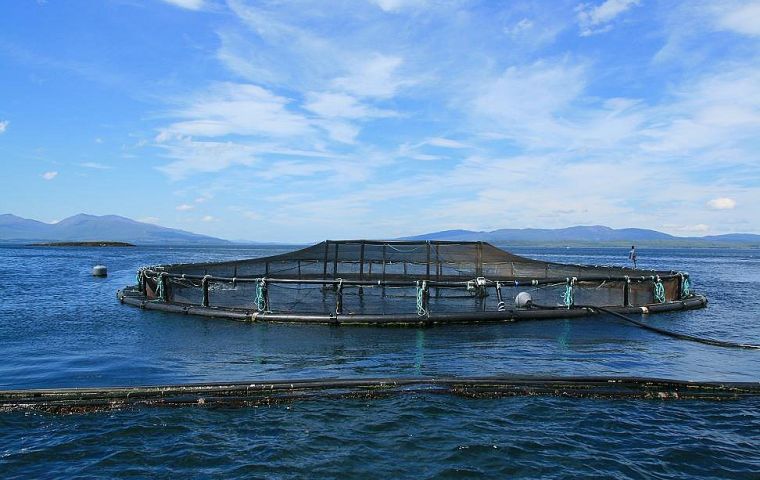MercoPress. South Atlantic News Agency
Farmed salmon industry booming and has become the main global fisheries export
 Global production of Atlantic salmon in 2020 was 2.71 million tons, 32.6% of fish aquaculture. It is followed by dairy fish with 1.16 million tons, FAO Sofia report
Global production of Atlantic salmon in 2020 was 2.71 million tons, 32.6% of fish aquaculture. It is followed by dairy fish with 1.16 million tons, FAO Sofia report Farmed salmon exports totaled US$ 27.6 billion in 2020, surpassing exports of other categories of fish, according to the latest release of a biennial report from the UN Food and Agriculture Organization (FAO).
The State of World Fisheries and Aquaculture Report 2022, (SOFIA) showed that Atlantic salmon remains the dominant species farmed in marine waters around the world, making it one of the main drivers of growth in global trade in fisheries and aquaculture products in recent decades.
In effect, according to FAO, the global production of Atlantic salmon in 2020 was 2.71 million tons, or 32.6% of fish aquaculture. It is followed by dairy fish with 1.16 million tons, or 14% of the world's farmed fish production.
“As a versatile and valuable species suitable for large-scale aquaculture, salmon has a strong competitive position in the global market,” SOFIA points out in the report.
“Aquaculture of Atlantic salmon has become one of the most profitable and technologically advanced industries. The sector also leads the way in financing, coordinating and executing large-scale international marketing campaigns and has successfully established a logistics infrastructure to bring fresh aquatic products to overseas markets via air routes.”
In 2020, salmon exports totaled US$ 27.6 billion, led by Norway (US$ 11 billion or 7.4% of the global total) and Chile. Salmon and trout exports accounted for 18.4% of the value of all exported aquatic products in 2020, compared to 5.1% in 1976.
The FAO report also notes that the salmon farming sector's resilience to the initial price drop at the start of the COVID-19 pandemic, as well as subsequent logistical difficulties, “reflects the strength of underlying demand and the sector's ability to adapt to changing conditions.”
The total world aquaculture production in 2020 reached a record 122.6 million tons, with a trade value of US$ 264.8 billion. About 68 million tons are in the category that salmon belongs to: marine and coastal aquaculture.
“We are eating more seafood than ever,” the report underlines. “In 2020, people ate some 20.2 kg per capita, more than double the level of consumption 50 years ago.” FAO expects per capita consumption of farmed and wild seafood to increase by about 6% in 2030 to 21.4 kg per capita.
This will be driven by rising incomes, increased production, improved post-harvest operations and distribution, and changes in dietary trends.
FAO Director-General Qu Dongyu sees “big opportunities” in the fisheries and aquaculture sector amid current global challenges.
Aquatic products play a vital role in the food and nutrition security of many people around the world, but urgent action is needed to “preserve, protect, restore and sustainably manage marine ecosystems” or the ocean will not be able to maintain this role, he warned. (FIS/MP)




Top Comments
Disclaimer & comment rulesCommenting for this story is now closed.
If you have a Facebook account, become a fan and comment on our Facebook Page!